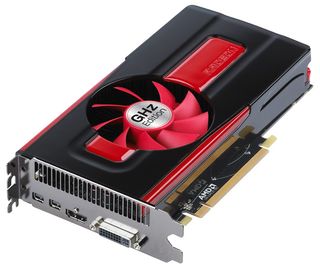A Round Up of the AMD Radeon HD 7790 Variants
Following its release last week, the AMD Radeon HD7790 graphics card is available from a wide variety of manufacturers with a range of coolers and clock speeds.

The highly anticipated AMD Radeon HD 7790 arrived on March 22 (read our review here) and since then we've seen a deluge of variants released from a wide range of manufacturers. Based upon the releases consolidated in the table below, the HD 7790 will be either released at stock specifications (excepting cooler designs) or with very minimal factory overclocks.
Specifically with regards to the quantity of on-board memory, we can speculate that this seems to be intended to prevent the graphics card from outperforming the more expensive Radeon HD 7850.
| Name | GPU Clock | Memory | Memory Clock | Cooler | Price |
|---|---|---|---|---|---|
| AMD Reference HD7790 | 1000 MHz | 1 GB GDDR5 | 6000 MHz | Reference | $149.99 |
| Asus Radeon EAH7790 DirectCU II OC | 1075 MHz | 1 GB GDDR5 | 6400 MHz | DirectCU II | $159.99 |
| Asus Radeon EAH7790 DirectCU II | 1000 MHz | 1 GB GDDR5 | 6000 MHz | DirectCU II | $149.99 |
| Club3D Radeon HD7790 ’13 Series | 1030 MHz | 1 GB GDDR5 | 6000 MHz | Custom In-House | $149.99 |
| Gigabyte GV-R779OC-1GI | 1075 MHz | 1 GB GDDR5 | 6400 MHz | Triangle Cool | $159.99 |
| Gigabyte GV-R779-1GI | 1000 MHz | 1 GB GDDR5 | 6000 MHz | Triangle Cool | $149.99 |
| HIS Radeon HD7790 iCooler | 1000 MHz | 1 GB GDDR5 | 6000 MHz | iCooler | $149.99 |
| MSI Radeon HD7790 | 1050 MHz | 1 GB GDDR5 | 6000 MHz | MSI Propeller Blade | $149.99 |
| PowerColor TurboDuo HD7790 OC | 1075 MHz | 1 GB GDDR5 | 6000 MHz | TurboDuo Dual-Fan | $159.99 |
| PowerColor HD7790 OC | 1030 MHz | 1 GB GDDR5 | 6000 MHz | Custom In-House | $149.99 |
| Sapphire Radeon HD 7790 Dual-X | 1075 MHz | 1 GB GDDR5 | 6400 MHz | Dual-X | $159.99 |
| Sapphire Radeon HD 7790 | 1000 MHz | 1 GB GDDR5 | 6000 MHz | Custom In-House | $149.99 |
| VTX3D HD7790 X Edition | 1030 MHz | 1 GB GDDR5 | 6000 MHz | Custom In-House | $149.99 |
| XFX Radeon HD 7790 Ghost | 1000 MHz | 1 GB GDDR5 | 6000 MHz | Ghost Cooler | $149.99 |
Stay On the Cutting Edge: Get the Tom's Hardware Newsletter
Get Tom's Hardware's best news and in-depth reviews, straight to your inbox.
-
dalethepcman I think the exhaust direction is more useful information than the marketing name the manufacturer gave to their fan, but thanks for the quick list.Reply -
Onus With the vastly superior GTX650Ti Boost available for only another $20, this one needs to come down even more to be relevant.Reply
-
blackcat357 You also missed the fact that Gigabyte has a 2gb DDR5 card on their website. GV-R779OC-2GDReply -
markwp Onus -- Vastly superior? See: http://www.hardwaresecrets.com/article/Radeon-HD-7790-vs-GeForce-GTX-650-Ti-BOOST-Video-Card-Review/1754/15 and note that the GTX is a 2gb vs the 1gb 7790 and STILL doesn't get there.Reply -
Onus The reviews I've read ended up more like this one: http://www.hardocp.com/article/2013/03/26/nvidia_geforce_gtx_650_ti_boost_video_card_review/11 with the GTX650Ti Boost superior across the board. Without implying dishonest intent on anyone's part, I think the HardOCP review is the better of the two.Reply
-
kylerg OnusWith the vastly superior GTX650Ti Boost available for only another $20, this one needs to come down even more to be relevant.Reply
Vastly superior? You do know the definition of vastly, right? I'm not trying to insult your intelligence but vastly should not be used. The GTX 650 Ti BOOST is better but it's also more expensive. Sure $20 is not all that expensive but it does make a difference on price to performance ratio. I, personally, would rather save $20 and have the 7790 which can perform (almost) as well as the 650 Ti BOOST. -
Onus I understand your POV, the frame rate difference is definitely not "vast," however, at this performance level, even a small difference can mean one more setting that doesn't have to be lowered. Seventy vs one hundred FPS might more properly be called "vast," but in actual play I probably wouldn't notice a difference.Reply
This summary comment perhaps best illustrates my point: "The GeForce GTX 650 Ti Boost allows you to play at high settings at 1080p in today's games, whereas the Radeon HD 7790 allows you to play at medium settings at 1080p in today's games." To me, that's pretty vast (even though I've said myself that medium looks pretty good in today's games).
-
JackNaylorPE kylergVastly superior? You do know the definition of vastly, right? I'm not trying to insult your intelligence but vastly should not be used. The GTX 650 Ti BOOST is better but it's also more expensive. Sure $20 is not all that expensive but it does make a difference on price to performance ratio. I, personally, would rather save $20 and have the 7790 which can perform (almost) as well as the 650 Ti BOOST.Reply
I think where he is going is the ROI aka Return in Investment .... which is almost 2 to 1.
http://www.tomshardware.com/reviews/geforce-gtx-650-ti-boost-gk106-benchmark,3463-11.html
THG shows a 25% difference in relative performance for a 13% increase in price which tosses the usual law of diminishing returns right out the proverbial window.....or in THG's words:
With the Radeon HD 7770 at $120, Radeon HD 7790 at $150, and Radeon HD 7850 above $180, Nvidia is rendering all three products ineffectual at their respective price points. With one swift stroke, the company engineered a hostile takeover of the $100-$200 market, increasing graphics performance at any given budget in that space.
